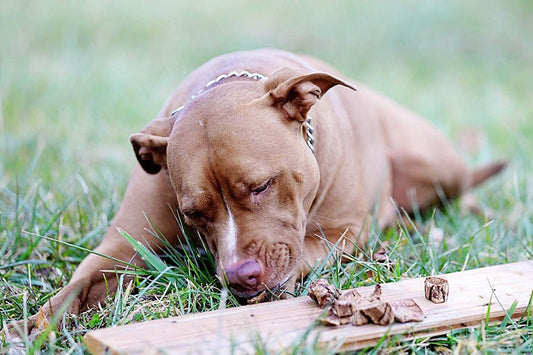From Bone to Joint: How Dog Bones Support Canine Mobility
Dawn Miller Jul 02, 20245 Minute ReadIt's a quiet morning. I'm sitting here by my breakfast nook window, sipping some homemade bone broth and reminiscing about my late Golden Retriever, Max.
A loyal companion, she always knew how to brighten my day with that wagging tail and boundless energy. Our family enjoyed many hiking excursions over the years.
The kids are grown and in college now, but they still tell stories. There was a time when Max was unstoppable, bounding through the little patch of woods behind our house, chasing squirrels and rabbits. But as she aged, she slowed down as we all do. As her joints stiffened, she didn't want to get up and play with the kids anymore, preferring to sit by the fireplace on her orthopedic dog bed.
This experience was eye-opening to me as a dog mom. I suddenly became aware of the importance of preventive care for dogs and why it's vital to start dog joint supplements earlier rather than later.
Now, as a dedicated pet mom to three boisterous dogs, I am committed to doing everything in my power to avoid that. Loss of mobility in the hip and joint for dogs is not the fate I have planned for me or my dogs. As I explored solutions, I wanted to share a little of what I learned.
The Nutritional Backbone of Canine Joint Health
When it comes to joint health, certain joint supplements stand out. You've probably heard of glucosamine, chondroitin, collagen, and hyaluronic acid. These substances act as the building blocks for joint supplements for dogs and are essential in preventing and alleviating joint issues.
For humans, glucosamine and chondroitin have been approved in Europe as medical treatments for Osteoarthritis for some time. They're also considered supplements in the USA. Hyaluronic acid is found in a lot of beauty products and medspa treatments because of its ability to help tissues stay hydrated. And collagen, of course, is the most prevalent protein in the human body.
Dogs aren't much different from humans when it comes to needing these compounds for joint mobility.
Here's a quick breakdown of how current scientific research believes these work to improve hip and joint for dogs.
Glucosamine for Dogs
Glucosamine is a key component in the synthesis of glycosaminoglycans, which are vital for maintaining the health and resilience of joint cartilage. Similarly, chondroitin is a naturally occurring molecule that strengthens the connective tissues in joints. Dog glucosamine and chondroitin appear to work best together. They aid in damping down inflammation and repairing cartilage, providing a double-action approach to joint care.
Studies suggest that glucosamine with chondroitin may reduce joint pain and swelling in those suffering from joint degradation. It may also work as a preventive by reducing joint space narrowing, which is a sign of joints repairing themselves.
French researchers also found that glucosamine and chondroitin could reduce the progression of joint damage in human athletes. I don't know about your dogs, but mine would hold their own in a competition. So, I know they need that athlete-level of joint support.
All in all, these nutrients work as both prevention and support after your dog shows the signs of arthritis. I wish I'd known then what I know now.
Collagen for Dogs
Collagen is also critical for dog joint health, as it is for mine. As the primary protein in the body, it forms the latticework that bones, joints, skin, and muscles are built on. When one of these vital structures is damaged, collagen helps the body reassemble that structure. It's woven throughout the tissues to reinforce structural integrity. Studies have shown that supplementing collagen can:
- Improve skin elasticity and hydration
- Support healthy bones and joints
- Shorten wound healing time
- Reduce pain and swelling in those already experiencing joint problems
For dogs, especially those like mine who are constantly on the move, collagen helps to cushion their joints against wear and tear, promoting smooth and pain-free movements. Supplementing a dog's diet with collagen can be particularly beneficial as they age, helping to combat the deterioration of joint health and maintaining their vitality for longer. This makes buying collagen-rich treats and supplements a smart addition to any proactive pet care regimen.
The Natural Source of Glucosamine Chondroitin
I don't know about you, but I opt for natural solutions when I can. I prefer to get my own nutrition from real food—some of which I grow myself. You should see my garden! I think the same way about dog joint supplements. So, I started looking for where glucosamine comes from.
Of course, I can give my dogs pills. But why would I do that when there are safe and natural ways that my furry kids love to take their dog joint supplements? I found it in the least expected place—dog bones.
Bone marrow combines the necessary amino acids to build collagen for the body, making it a rich source of collagen. It's also a rich source of glucosamine and chondroitin. Bones also provide essential dog bone and joint health nutrients like calcium, phosphorus, and magnesium.
You know, it makes sense now. Glucosamine and chondroitin are compounds that are found in bones and joints—not just in humans or dogs but in all animals. But some bones like those from rabbits, squirrels, and birds—including chicken and turkey—are dangerous. They can splinter and tear my sweet pups' digestive tracts.
I found the best dog joint supplement to be meaty beef marrow bones. These bones are sturdy enough not to shatter, even with my aggressive chewer lab mix, Bruno.
Choosing the Right Bones
It's crucial to ensure safe bones for dogs. They shouldn't splinter but they also don't need to be so hard that they damage teeth. Size is also important, as dogs should never be allowed to swallow bones or bone fragments. They should be big enough to prevent this, even among aggressive chewers.
I get the long-lasting bones, but I also don't let my dogs chew on marrow bones unattended, just in case.
They get to enjoy their bones as a treat two to three times a week for 10-20 minutes. That way, I can watch them. Plus, the bones last longer.
It's important to choose cooked bones to kill pathogens. But bones intended for dogs must be slow-cooked at low temperatures while retaining tasty bits. I also choose bones from grass-fed cows because of the added nutrition in grass-fed cattle. These Mammoth Marrow-filled Bones are some of Bruno's favorites.
Free Marrow Refill Recipe Guide
Engaging in an Active Lifestyle
On the topic of dog bone and joint health, it goes beyond dog chew bones. Just like I raised my kids, I try to keep my dogs active and engaged in activities they love. Regular exercise, like our daily walks in the neighborhood and several monthly hikes through the Ohio woods, helps keep my dogs' joints healthy. Dog bones are an important part of my dogs' overall healthy diet, designed to keep them agile and pain-free.
Final Thoughts on Joint Supplements for Dogs
I can't go back and do things differently for Max. But she has left a legacy on our family and shaped how I care for three dogs today. I do what little I can to help them live vibrant, healthy, and happier lives. I want to feed their instincts with the meaty flavor of grass-fed beef marrow bones, so I get joint supplement for dogs that I know they enjoy.
Available On:
Disclosure: This article may contain affiliate links, which means we may earn a small commission if you make a purchase through these links—at no extra cost to you. We only recommend products we trust and believe will benefit you and your K9.






